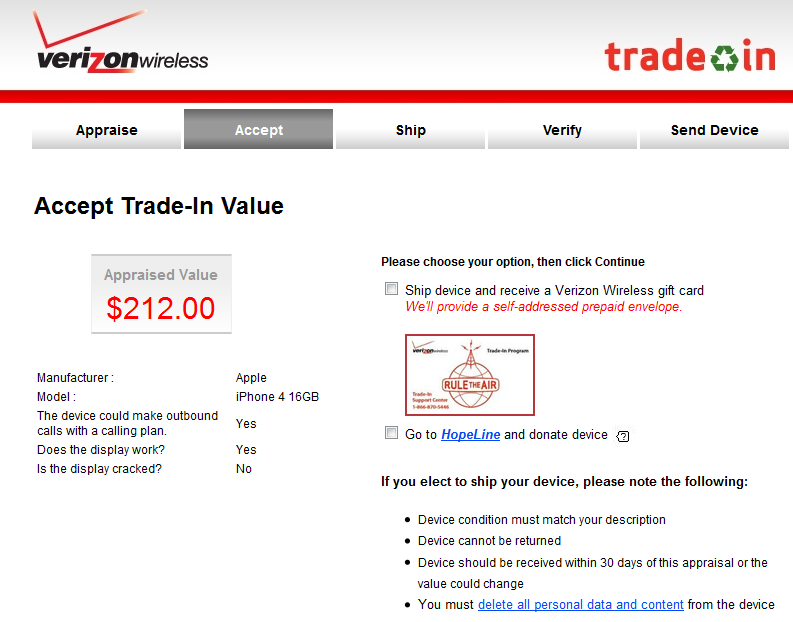AT&T, Verizon Wireless trade-in programs may change smartphone buying process

Verizon Wireless launched a trade-in program ahead of the launch of the iPhone and AT&T quickly followed. These efforts may just change the smartphone buying process and minimize the reliance on two-year contracts.
On Thursday, AT&T rolled out its version of Verizon's program. In a nutshell, AT&T's trade-in process revolves around its retail stores. AT&T reps will evaluate the trade-in phone and then facilitate the swap. The program, which is handled through a company called, FlipSwap gives consumers a promo card worth the value of the phone.
This trade-in model offsets the price of a new device (assuming you just have to have one). I called Verizon about this trade model earlier this week. In a nutshell, you refresh your device, but the two-year contract stays.
What's unclear to me is whether these trade in economics work better than paying a little more for a phone and taking a one-year contract. In other words, every case is different. One thing is certain: Trade-in policies are likely to lead to more churn at wireless carriers. Bernstein analyst Craig Moffett writes in a research note:
For customers who bought their AT&T iPhones before June of last year, AT&T's early termination fee is calculated as $175 less $5 for each month of the contract honored. For a customer who signed a two year contract with AT&T in last May, then, the early termination fee would be $135. For a customer who bought a 3GS when it first became available a year earlier, in June 2009, the early termination fee would be $80. In either case, Verizon's Trade-In would likely make the buyer whole. Costless switching.
For customers who bought after June of last year, when AT&T revised their early termination fee calculation (and when AT&T introduced the iPhone 4), the exit cost is higher. AT&T's calculation is now $325, minus $10 for each completed month. So if you bought an iPhone 4 the week it launched in June 2010, you'll owe AT&T ~$255. Still, with the total dropping by $10 per month, customers need wait only a few more months and Verizon's trade-in subsidy fully pays their early termination fee. Feeling locked in by a large fixed investment in iPhone apps? Apple and Verizon have that covered, too. Connect to iTunes and all those apps will be smoothly ported over.
Here's another Verizon walkthrough. Say I have an AT&T iPhone. I go to Verizon's trade-in site and it's appraised at $212.
As discussed earlier, the math works out like this for someone leaving AT&T for Verizon.
In my situation things are a bit more complicated. I have an every-two promotional credit for $50 at Verizon (until early summer). That credit only works for a two-year contract. I'm waiting for an 4G phone, but my current phone is barely operational.
Current choices are:
- Get a phone with two-year contract with $50 credit, but be locked into 3G.
- Take a one-year contract, but lose the credit.
- Wait another three months for either an LTE phone or stretch things out to the summer and see what happens with iPhone 5.
The one-year plan combined with the trade-in program increasingly looks like a good move. A lot of this is perception: I don't want to be locked into a contract. Sure, Verizon has nixed an upgrade credit, but trade-ins could alter the buying calculus a good bit as an escape hatch.
It appears that the trade-in program almost makes all two-year contracts the equivalent of one-year deals---as long as you don't switch carriers. By eliminating the promotional $50 credit, Verizon is likely to see more one-year deals. My hunch is few of us really looked into these options. After all, most of us just blindly buy two-year contract phones.
Here's an illustration of a Droid Pro upgrade with my current situation.
Here's the one-year deal:
And the two-year:
In a nutshell, an $80 swing (including the loss of the $50 discount) is worth buying the freedom to upgrade 10 months from now when LTE is fully baked and I can renew possibly for two years down the line. I can always trade in the phone later. The caveat: A phone depreciates as soon as you pick it up. I could buy the Droid Pro tomorrow, trade it in next week and fetch $92 for it.
Related:
- Verizon iPhone: the Fine Print
- Verizon slashes pricing on Motorola Droid R2-D2 edition
- Motorola Mobility: We're already seeing a Verizon iPhone induced slowdown
- Verizon to charge $20/mo. for iPhone personal hotspot
- AT&T finds love with Android
- Verizon, Apple Stores will open at 7AM on February 10 for iPhone 4
- AT&T CEO: Verizon iPhone means volatile first half, but confident about Android
- Net Neutrality alert: Verizon to throttle data speeds for heaviest users
